

Camilla Valley Farm Weavers' Supply is pleased to offer hundreds of books on Fibre Arts related topics. Below (and at the other links above) are detailed descriptions for a subset of the books available. The full list of books can be found at:
Also note that occasionally books become unavailable or a new source for out of print books is located. While we will try to provide books out of our inventory and/or can order them from our suppliers, sometimes this may not be possible. We will advise if a situation like this exists when you place your order, or you can contact us and we will verify availability before you order.
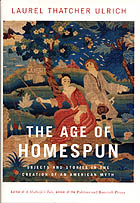
by Laurel Thatcher Ulrich
6 1/2" x 9 1/2" Hardcover (501 pages)
2001, Alfred A. Knopf
NO LONGER AVAILABLE (CURRENTLY OUT OF PRINT)
Using objects that Americans have saved through the centuries and stories they have passed along, as well as histories teased from documents, Laurel Thatcher Ulrich chronicles the production of cloth - and of history in early America.
Under the singular and brilliant lens that Ulrich brings to this study, ordinary household goodsIndian baskets, spinning wheels, a chimneypiece, a cupboard, a niddy-noddy, bed coverings, silk embroidery, a pocketbook, a linen tablecloth, a coverlet and a rose blanket, and an unfinished stocking-provide the key to a transformed understanding of cultural encounter, frontier war, Revolutionary politics, international commerce, and early industrialization in America. We discover how ideas about cloth and clothing affected relations between English settlers and their Algonkian neighbors. We see how an English production system based on a clear division of labor-men doing the weaving and women the spinning - broke down in the colonial setting, becoming first marginalized, then feminized, then politicized, and how the new system both prepared the way for and was sustained by machine-powered spinning.
Pulling these divergent threads together into a rich and revealing tapestry of "the age of homespun," Ulrich demonstrates how ordinary objects reveal larger economic and social structures, and, in particular, how early Americans and their descendants made, used, sold, and saved textiles in order to assert identities, shape relationships, and create history.
Laurel Thatcher Ulrich is Phillips Professor of Early American History at Harvard University. Formerly a professor of American history at the University of New Hampshire, she is the author of Good Wives (1982) and numerous articles and essays on early American history. She won the Pulitzer Prize for History in 1991 for A Midwife's Tale: The Life of Martha Ballard Based on Her Diary, 1.7S5-1812. Born and raised in the Rocky Mountain West, she has lived in New England since ig6o. During her tenure as a MacArthur Fellow, she assisted in the production of a PBS documentary based on A Midwife's Tale. Her work is also featured on an award-winning Web site called dohistory.org. She and her husband, Gael Ulrich, are the parents of five grown children.
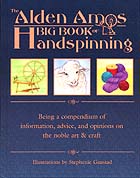
by Alden Amos
7 1/4" x 9 1/4" Hardcover (495 pages)
2001, Interweave Press
NO LONGER AVAILABLE (CURRENTLY OUT OF PRINT)
If you are interested in spinning your own fibers into yarn, this is the book for you. It will answer nearly any question you have on spinning and spinning related areas as well as many, many more questions that you haven't even thought of yet!
The author, a legend in the handspinning community, has compiled nearly forty years worth of wisdom in one big book and describes this book on the front cover as "being a compendium of information, advice and opinions on the noble art and craft"! The Alden Amos Big Book of Handspinning is packed full of useful information and historical perspective designed to help readers increase their self-confidence and expand their skill base in the craft of handspinning. Amos educates with humor and wit, unleashing his traditional textile wisdom onto the page while preserving the spirit and personality behind his words. Whether you're a veteran handspinner, or just beginning, this book offers insight appropriate for every skill level.
The book is written in a conversational tone filled with humor and seasoned with the author's personal anecdotes. This style coupled with clear how-to instructions on performing almost every process connected with handspinning makes this book a wonderful way to learn a lot about spinning anything from cotton & flax to wool & silk!. In addition, the construction plans for many common tools (ie. yarn winder, wool combs, notespinne, niddy noddy, etc.) found inside, make this book the perfect choice for any handspinner who knows a woodworker who owes them a favour!
From spinning fibers to making and handling yarn, The Alden Amos Big Book of Handspinning contains a wealth of spinning information including washing fleece, rotating wheel position, dissolving lanolin and choosing types of wool. Also discussed are various hand positions, which can result in everything from smooth, fine thread to funky, bulky yarn.
This is a fabulous reference for any handspinner and a must for his/her spinning library and is well illustrated with many line drawings.
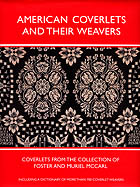
by Clarita S. Anderson
9 1/4" x 11 1/4" Hardcover (247 pages)
2002, The Colonial Williamsburg Foundation
NO LONGER AVAILABLE (CURRENTLY OUT OF PRINT)
Coverlets woven in vibrant colors of red, blue, white, and green are as popular today as they were in the nineteenth century. American Coverlets and Their Weavers: Coverlets from the Collection of Foster and Muriel McCarl is a lavishly illustrated guide to one of the premier collections of coverlets in the nation. As such, it is also an essential reference for collectors, historians, specialists in material culture, and others who are interested in American textiles.
Figured and fancy bed coverlets tell the stories of the people who made and used them. They also document the important nineteenth-century transition from handloom weaving to mechanized factory production. Trained weavers who immigrated to America often first worked in factories to save enough money to start their own businesses. Many of them lasted only a year or two before turning to farming as a more lucrative occupation.
Coverlets help people today understand more fully the lives and material culture of the mostly middle-class rural Americans who purchased them. Clients boldly proclaimed their patriotism, piety, interest in current events, and design preferences through the colorful coverlets they chose to grace their bedchambers. The brilliant colors, complex designs, and historical associations argue for the lasting importance of figured and fancy coverlets to the arts and history of early America.
This book includes full colour pictures and a detailed analysis of 50 unique coverlets from New York, New Jersey, New Hampshire, Pennsylvania, West Virginia, Virginia, Ohio and Indiana to provide the reader with historical insight into both the design itself and weaver that produced it. Beautifully illustrated with over 120 full colour photographs of the covelets, this wonderful book includes a dictionary of more than 700 coverlet weavers with detailed biographical information on each.
Other books by the author include Weaving a Legacy - The Don and Jean Stuck Coverlet Collection.
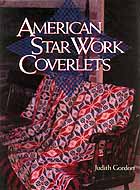
by Judith Gordon
8 3/4" x 11 1/4" Hardcover (152 pages)
1995, Design Books
NO LONGER AVAILABLE (CURRENTLY OUT OF PRINT)
Most of the coverlets in North America were woven between the end of the eighteenth century and the Civil War, by women in towns and on farms, and by professional weavers who brought with them from Europe a detailed knowledge of weaves and cloth structures necessary to create the popular geometric-patterned coverlets reproduced in these pages. Using the term star work to embrace the wonderful star, diamond and flower motifs that were beloved of the nineteenth century, and are equally appealing today, weaver Judith Gordon assembles here a collection of 80 coverlets, most Pennsylvania German in origin, and explains their history and construction.
The information given with each coverlet - including colour, fibre, size, and other pertinent notes, as well as weaving drafts and photographs that convey the thread-by-thread quality of the textiles - is sufficient for a weaver to reproduce the designs exactly. But this book is not just for weavers and collectors. Anyone who takes inspiration from the past can apply the patterns to his or her own purpose: other forms of textile decoration, needlepoint and embroidery, knitting, even wood carving and pottery. A celebration of weavers and their art, American Star Work Coverlets brings fresh inspiration to craftspeople of today from weavers of yesterday, rescues designs worthy of remembrance from the destruction of time, and preserves our heritage.
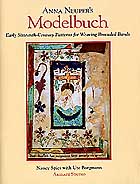
by Nancy Spies & Ute Bargmann
8 3/4" x 11 1/4" Softcover (56 pages)
2003, Arelate Studio
NO LONGER AVAILABLE (CURRENTLY OUT OF PRINT)
A small, leather-covered book of handwritten patterns for gold brocaded tabletwoven bands resides in the Herzog August Bibliothek in Wolfenbuttel, Germany. Written in 1517 by Anna Neuper, a seventy-year old nun in the St. Clare Convent in Nurnberg, it contains forty-five different patterns with variations and is among the earliest pattern books for any textile technique. These patterns have been transcribed into modern charts and are presented with background information by the authors. This book is a must for every tablet weaver and anyone who can work from graphed designs.
Other works by Nancy Spies include Ecclesiastical Pomp & Aristocratic Circumstance - A Thousand Years of Brocaded Tabletwoven Bands.
CLICK TO SEE OUR TABLET WEAVING CARDS AT A VERY AFFORDABLE PRICE!
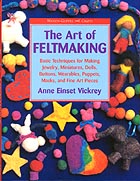
by Anne Einset Vickrey
7 3/4" x 10" Softcover (144 pages)
1995, Watson-Guptill Publications
$30.95 Canadian ($25.95 US)
Basic Technique for Making Jewelry, Miniatures, Dolls, Buttons, Wearables, Puppets, Masks and Fine Art Pieces
When heat, moisture, and pressure are applied to wool, its fibers bond together to create felt. This elemental phenomenon provides the basis for the craft of feltmaking, whose appealing simplicity is also reflected in its material requirements: Besides wool, water, and soap, you need a surface on which to agitate or "full" the wool, a sharp pair of scissors, and, if the project requires it, a pattern. The basic techniques have many applications, and are so easy that even a young child can master them.
Using just four basic techniques, The Art of Feltmaking shows how to create a variety of felt projects. The book begins with an overview of the history of the craft, which is followed by a detailed survey of materials and tools. Each feltmaking technique-making felt ropes, felt beads, flat felt, and seamless felt-is then demonstrated with step-by-step photographs and detailed instructions. By combining and varying these four methods, you can make these and many other projects: Jewelry including necklaces, bracelets, earrings, pins, barrettes, and buttons; Wearables like slippers, mittens, hats, and doll apparel; Toys and Figures including felt balls, simple rope-and-bead figures, poseable dolls, finger puppets, hand puppets, and stuffed toys; Vessels like pouches, purses, and boxes; Masks like eye masks, large masks, and masks with three-dimensional features.
With The Art of Feltmaking as your guide, there are no limits to what you-and your kids-can create with felt. This book is well illustrated with 246 colour and 30 back and white pictures.
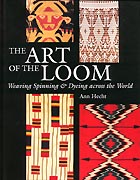
by Ann Hecht
8 1/4" x 11 Softcover (208 pages)
2001, University of Washington Press
NO LONGER AVAILABLE (CURRENTLY OUT OF PRINT)
Colourful and sometimes complex textiles are still produced in many parts of the world using only the simplest tools and equipment. This book focuses on eight areas of special interest - Navaho weaving in North America; bedouin textiles in the Middle East; West African narrow-strip weaving; Indonesian textiles; "kasuri" resist dyeing in Japan; inlay weaving in Nepal; brocaded motifs from Guatemala; and Peruvian tapestry weaving - and describes the fibres used, the methods of spinning and dyeing, the types of loom and the techniques of weaving. Examples of the best textiles from each area are supplemented with numerous photographs of spinners, weavers and dyers at work, and diagrams showing how the various effects are achieved. As well as providing students - and anthropologists with a valuable insight into working methods in a wide variety of traditional communities, this book and the exciting textiles it illustrates will be an endless source of ideas and inspiration for practicing weavers.
Ann Hecht taught weaving, spinning and dyeing for seventeen years in adult education, and for many years she designed and produced the Journal for Weavers, Spinners and Dyers. Recently she has been studying the Guatemalan textile collection in The British Museum and is the author of Textiles from Guatemala in the Fabric Folios series.
This is a wonderful book with 169 illustrations, 60 in colour.
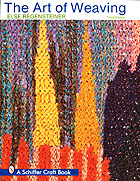
by Else Regensteiner
8 1/2" x 11" Softcover (192 pages)
1986, Schiffer Publishing Ltd.
NO LONGER AVAILABLE (CURRENTLY OUT OF PRINT)
Weaving has many faces: it is a craft. a medium for working directly with fundamental materials to create joyful mixtures of textures and colors, to feel the accomplishment of mastering the tools and learning the steps, and to explore the discipline of fine craftsmanship. It is an art, an expression of our time, which can have the brilliance of a painting, the dimensions of sculpture, the shape of invention, and the form of imagination. It is functional, intimately related to us through our daily use of fabrics. It is an industrial product made speedily by the power loom, but unchanged in its basic construction of interlocking threads, and it is as an individual as its creator will make it. It is a tool for the educator and a technique for the therapist; it is romantic and sober, ancient and contemporary. --- from the Preface
In comprehensive text, diagrams, drafts and examples of fine woven fabrics, this book about the art and craft of weaving offers complete coverage of the materials and equipment, the techniques and, most important, the creative possibilities of the medium.
The Art of Weaving is an indispensable handbook for every weaver, beginner and expert. Included here are not only the fundamentals of weaving - essential information about looms and other equipment, yarns, how to design a warp and warp the loom, drafting, the basic weaves, and pattern weaves, but also how to apply this knowledge to discover the many faces of weaving. Many different weave structures are covered: double weaves, tapestry techniques, knotted, pile, and flat-woven rugs, and two- and three-dimensional wall hangings.
This book not only teaches the techniques, simple and complex, of weaving; it stimulates creative expression. An entire chapter is devoted to design - composition, color, form annd function, the sources of inspiration.
Every weaver will appreciate, too, these special features of The Art of Weaving: how to make and weave with a back-strap loom, how to estimate yardage for warp and weft, how to convert rising-shed loom directions for use with a sinking shed; how to read any draft, and a comprehensive glossary of the weaver's language.
With many diagrams and drafts and over 200 black-and-white and color photographs of the finest contemporary weaving.
The authors other books include: Geometric Design in Weaving and Weaving Source Book.
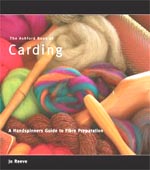
by Jo Reeve
8 1/2" x 9" Softcover (92 pages)
2006, Willson Scott Publishing Ltd.
NO LONGER AVAILABLE (CURRENTLY OUT OF PRINT)
This is a practical and inspirational guide to carding fleece, slivers and exotic fibres. Written for the hand spinner and felter, and everyone who loves fibre, there are sections on using flick, hand and drum carders, fibre and colour blending, colour theory and four innovative projects. Step by step instructions and full colour photographs envelope you in the world of colour, texture and the endless possibilities of fibre. The book includes tutorials on Flick Carding, Hand Carding, Drum Carding, Fleece to Sliver, Colour Blending and Fibre Blending. Projects include Self-striping Socks, Merino Mittens, Triangular Shawl and Merino and Silk Scarf. by Ann Milner
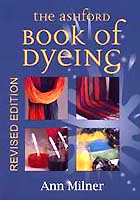
The Ashford Book of Dyeing - Revised Edition
7" x 9 3/4" Softcover (192 pages)
1998, Shoal Bay Press
The Ashford Book of Dyeing is a comprehensive, clearly written introduction to the wonderful world of color - placed on fabric exactly how and where you want it.
The text is immediately accessible to the absolute beginner. From an outline of basic principles, the author takes a step-by-step approach describing fabrics, relevant dyes and techniques. For the more experienced dyer, she also provides detailed recipes for named dyes, instructions for advanced techniques and a very clear discussion of percentage dyeing, a system that enables the dyer to recreate exactly a specific shade or color.
This new edition of The Ashford Book of Dyeing now also includes a chapter of projects which guides the dyer through a series of practical exercises designed to help develop an appreciation and understanding of the techniques involved.
In an extensive section on natural dyeing, Ann Milner details the results of her own experiments with a wide range of natural dyestuffs and encourages the dyer in an exploration of his or her own environment. As she says, "The joy of using natural dyes is discovering them for yourself. The aromatic smell of the yarn and the soft, warm, subtle colors will be your reward."
There are chapters on dye bath dyeing for protein and cellulose fibers; on direct application methods such as cold pad batch dyeing, screen and block printing, painting or spraying; dyeing silk using modern purpose-designed dyes; and resist dyeing techniques, including batik. The author shows how to achieve novelty effects with hot exhaust dyeing and how to use such novel heat sources as the sun and the microwave oven.
She also includes a thoughtful and useful outline of the principles of working with color. This is illustrated with color plates of value charts and graduated triangles which display examples of the wide range of shades available through percentage mixing of dyes.
The book is illustrated with clear photographs demonstrating techniques and a number of color photographs illustrating the brilliant results that can be achieved. It has a comprehensive bibliography and a useful index of named dyes and dye classes.
If you are setting out to work with a particular fabric or a specific dye; if you are looking for a required effect; if your interest is in natural dyes, ancient indigo dyes or the modern fiber reactive and ready-mixed silk dyes, The Ashford Book of Dyeing will provide invaluable information and guidance...and inspiration.
The book is extensively illustrated with colour and black & white photographs and diagrams.
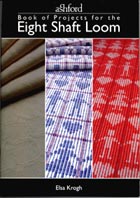
by Elsa Krogh
8 1/4" x 10 1/4" Softcover (39 pages)
2006, Portmanteau Print Ltd.
NO LONGER AVAILABLE (CURRENTLY OUT OF PRINT)
This book contains a variety of techniques from twill variations in the Scandinavian tradition to multishaft Summer & Winter and modern backed weaves. The new owner of an eight shaft loom and the experienced weaver will both find inspiration and challenges in this collection of placemats, towels, shawls, wall hangings, and suit material.
The 8 projects in this book include: "Towels with Pointed Twill Variations", "Placemats and Towels with Twill Blocks", "Scarf with Pleats", "Shawl in Swedish M's and O's", "Placemats with Roses and Matching Napkins", "Baby Towel and Wallhanging with Paperdolls" as well as two Backed Weaves for Clothing named "Lattice" and "Fashion Checks".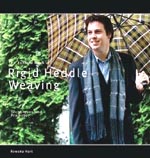
by Rowena Hart
8 1/2" x 9" Softcover (100 pages)
2008, Ashford Handicrafts
NO LONGER AVAILABLE (CURRENTLY OUT OF PRINT)
This is a New Revised Edition of the book with expanded content and more projects!
International weaving teacher Rowena Hart shows how you can create exciting, beautiful garments and crafts - all on the simple two shaft loom. In this book she guides the reader step-by-step through the many techniques, showing just how easy it is to make your woven creations come alive through colour and texture.
Also known as the Rigid Heddle, this type of loom is simple to use, light and compact. It will produce fabrics and tapestries to delight you. The projects in this book have been designed with both novice and experienced weavers in mind. People new to weaving can simply follow the projects as outlined. Exerienced weavers could find new directions.
The projects in the book include Colour and Weave (4 scarves), Tapestry Weaving (4 Mug Rugs), Rya Fleece Rugs (3 Rug patterns), Textured Cushions (2 designs), Handwoven Cloak (Black Cloak & Dark Grey Cloak with Collar), Shibori (3 Table Mats), Silk Textures (Silk Scarf), Cushions (2 designs), Small Mats (5 designs), Scented Wall Hanging, Hand Towels (3 designs on one warp), Leno Lace scarf, Bronson Weave Scarves (Wool and Cotton Scarves), Surface Design Patterns (Bronson Cushion, Soumak Cushion), Brooks Bouquet (Place Mat, Table Runner) and Fine Weaving (Merino Sampler, Bronson Weave Neckpiece, Neckpiece in Wool and Silk and Summer and Winter and Taquete). Each project is beautifully illustrated with full colour photographs showing the finished designs as well as technique. A section at the beginning shows how to warp and weave with the rigid heddle loom using clear photographs and east to read instructions.
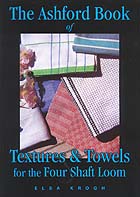
by Elsa Krogh
7" x 9 3/4" Softcover (32 pages)
2002, Shoal Bay Press
NO LONGER AVAILABLE (CURRENTLY OUT OF PRINT)
Towels are wonderful projects for the loom. You can weave small fingertip towels or large bath towels, this dishtowels for the kitchen or bulky towels for the bathroom. They are all useful, and they make excellent gifts.
For beginners there is the consolation that a towel will do its job even if the weaving is slightly irregular and the edges not quite straight. For advanced weavers , weaving towels is an excellent way to test unusual colour combinations, new yarns and interesting techniques.
Once you have put the warp on the loom, you don't have to make all your towels the same, so it is an obvious way to use up odds and ends of nice yarns and gorgeous colours. As well, a towel warp can be used for more than towels: the width and the materials are also suitable for placemats, cushions and bags.
The 8 designs in this book include: "Twill - Simple and Stylish" (2 variations: Natural with Dotted Pinstripes & Blue and Green Warp Stripes"), "Winter White Waffle", "Three Textures Side by Side" (Linen and Cotton Weft variations), "Thick and Thirsty Huckaback", "Checks and Stripes in Ms & Os" (2 variations), "Springtime Towels" (2 variations: Green and Turquoise), "Mock Damask" (4 variations: Off-white Warp, Blue Version, White Version and Mixed Red Warp) and "Chessboard in S&W". The designs are show on the book cover in colour and inside full instruction along with a black & white picture and tie-up drawings are provided for each as well as yarn information.
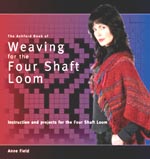
by Anne Field
8 1/2" x 9" Softcover (175 pages)
2007, Everbest Printing Company
NO LONGER AVAILABLE (CURRENTLY OUT OF PRINT)
This is the revised and updated version of the author's 1986 classic The Four Shaft Table Loom - An Introduction to Weaving.
Weaving is a particularly fascinating hobby. From the interweaving of fibres and the combining of the elements of colour, texture and design, comes the satisfaction of producing an imaginative and individual piece of fabric.
The four-shaft table loom is one of the most popular of the modern looms developed especially for use in the home. It produces a distinctive, crafted look in fabrics and is sufficiently versatile to appeal to beginner and experienced craftsperson alike. Yet few books have been written specifically for it's use, and the weaver must often struggle to adapt instructions, drafts and techniques to suit the table loom.
Anne Field, an experienced teacher of weaving and a craftsperson whose own work is highly regarded, has written this book with special attention to those that have no access to classes, and her clear step-by-step instructions guide the beginner through the weaving process.
Contents include yarns, planning the warp, warping the loom, weaving and pattern drafting, and descriptions of the techniques of weaving balanced weaves, twills, weaver-controlled weaves, weft-face weaves, overshot weaves and many more. Nearly 300 illustrations demonstrate aspects of the loom, techniques and pattern drafts and the twenty-five colour plates prove that the end results can be as diverse and interesting as delicate lacy shawls and heavily textured bedspreads.
The book also includes 14 projects with photographs of the finished garments and a full set of instructions. These projects include: Two Scarves - Chained and Linked - Tabby or Twill, Tablemats - Swedish Lace, Two Fleece Cushions, Upholstery and Clothing Fabric - Twill Inlay, Surface-Weave Fabric - Two in One, Cotton Jacket - Diverging Warp, Two Tencel Warps - Summer & Winter - Twill, Cocoon Jacket - Funky Mohair, Crossover Shawl - A Weavers Puzzle, Overshot Runner - Traditional Design, Weft-Face Hanging - Boundweave on Opposites, New Zealand Landscape - Textural Techniques, Warp-Face - Cut Pile and Throw - Double Weave.
The author has also written Collapse Weave - Creating Three-Dimensional Cloth.
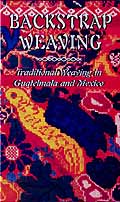
produced by Janet Willoughby
DVD Video (59 minutes colour)
An Ends of the Earth Surviving Traditions Production
NO LONGER AVAILABLE (CURRENTLY OUT OF PRINT)
Nowhere are the skills of backstrap weaving so widely practised as in Guatemala and Mexico. Everywhere weavers can be seen sitting down to weave , under a tree, in front of houses, inside open doorways. Complex and colourful designs reflecting thousands of years of tradition and skill are still produced from a few sticks and balls of yarn. This film unravels the secrets of backstrap weaving and shows how the ancient Amerindian cultures survive through it.
Filmed in Mexico and Guatemala. Contents: The backstrap loom ,warping up backstrap loom and different weaving techniques used to produce an amazing range of multicoloured huipils and cloths.
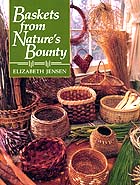
by Elizabeth Jensen
8 3/4" x 11 1/2" Hardcover (197 pages)
1996, Interweave Press
NO LONGER AVAILABLE (CURRENTLY OUT OF PRINT)
From weeds growing by the roadside to the vines and bushes in our own backyards, we're surrounded by materials for basket-making. Honeysuckle runners, cattail fronds, grasses, daylily leaves, even some common houseplants can be fashioned into beautiful and useful containers in just an afternoon or an evening. Their rich natural colours and distinctive textures bring special warmth to any home.
Baskets from Nature's Bounty gives thorough information on identifying, collecting, and preparing hundreds of plants for use, and complete instructions for crafting them into woven, plaited, twined and coiled baskets. A comprehensive "Harvest Calendar" provides a handy reference for gathering in season, and a 16-page colour gallery of contemporary baskets is here to inspire. More than 250 illustrations and photos, both technical and botanical, as well as 20 complete basket projects, make all the "how-to's" perfectly clear.
More than a manual on basket-weaving, Baskets from Nature's Bounty is an invitation to make use of the prolific resources of our immediate surroundings, to venture out into fields and woodlands, and to bring home the makings of beautiful and useful things. A basket from material you have gathered yourself will reflect the place where it grew, the time you discovered and prepared it, and the thoughts that went into shaping it for a long-appreciated second life.
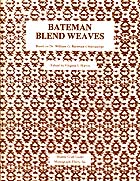
edited by Virginia I. Harvey
8" x 10 1/2"Softcover (137 pages)
1949, HTH Publishers
NO LONGER AVAILABLE (CURRENTLY OUT OF PRINT)
This is Shuttle Craft Monograph Thirty-six.
It documents a weave that is primarily a multi-shaft weave derived from the Summer and Winter system. After some basic definitions and an explanation of the draft structure used in this document, the Bateman Blend System is described and is followed by an overview of the structures of the system. The collection of drafts are then divided into divisions containing Six-Thread, Eight-Thread, Ten-Thread and Twelve-Thread Blocks. Finally sections covering variations of A, B and C Blocks and Three and Four -Tie Blocks round out the discussion.
Dr. G. Bateman spent his retirement years weaving sample, first on an inkle loom, then on an eight-harness Missouri table loom. He progressed through Inkle Weaves, Overshot, Twill, Crackle, Summer and Winter and other established techniques to variations on these weaves, and finally to the discovery of new weave systems. The culmination of his work was a manuscript that documents his weaves.
This is the 2nd volume in a series that reproduces the contents of Dr. Bateman's manuscript documenting his work in weaving samples. These have been reproduced in 6 monographs by the Shuttle-Craft Guild with this volume being Monograph Thirty-Eight. The other 5 volumes of Dr. Bateman's work are titled:Boulevard, Chevron and Combination Weaves, Extended Divided Twill Weaves, Extended Manifold Twill Weaves, Multiple Tabby Weaves and Park Weaves.
In these monographs, Dr. Bateman's text has been printed with no omissions, changes or alterations. His text, which is printed on a gray background, precedes the related text prepared by the editor. The only part of his manuscript that has been rewritten is the wefting directions. The information is the same, but the method of presentation has been changed to a more conventional form of tie-up and treadling. Missing samples were rewoven following Dr. Bateman's directions and using the choice of materials he suggested. The document is illustrated with treadling and tie-up diagrams as well as black and white pictures of the samples.
Click Here for a complete list of the monographs in the Shuttle-Craft Guild series.
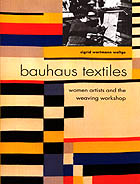
by Sigrid Wortmann Weltge
8 3/4" x 11 1/4" Softcover (208 pages)
1993, Thames and Hudson
NO LONGER AVAILABLE (CURRENTLY OUT OF PRINT)
When talented female students arrived to study at the Bauhaus, they soon discovered that the founder of the school, Walter Gropius, was not strictly adhering to his original declaration of equality between men and women. In the hierarchy of art and design, it was textiles that were deemed to be "women's work."
The new weavers responded to the challenge with remarkable virtuosity, pouring all their artistic energy and talent into this new field of interest. Ecgerly embracing advanced technology, they incorporated new or unusual materials (such as Cellophane, leather and early synthetics), creating reversible fabrics which had acoustic and light-reflecting properties. They produced multi-layered cloths, some with double and triple weaves, and later made extensive use of the jacquard loom. The result was a rebirth of hand-weaving and a new professionalism in designing textiles for mass production.
In this model study, superbly illustrated with rare or little seen photographs of the works themselves, Sigrid Wortmann Weltge recreates the atmosphere of creative excitement at the Bauhaus. Original archival research and interviews with survivors and their students, as well as with leading contemporary designers, detail the workshop's history and its enduring legacy: marvelous fabrics still being produced today. Bauhaus Textiles unearths the missing chapter in the story of the most important institution in the history of modern design.
The author is Professor in the History of Art and Design at the Philadelphia College of Textiles and Science. This wonderful glimpse into the past includes 220 illustrations, 122 in color and was also published in the USA under the title Women's Work.
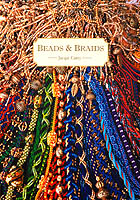
by Jacqui Carey
8 1/4" x 11 3/4" Softcover (192 pages)
1991, Carey Company
$59.95 Canadian ($49.95 US)
Decoration is a passion that is both universal and historical. It can serve a functional purpose or be purely frivolous. Beads and Braids are no exception. Both beads and braids can trace their origins to the dawn of civilization and the combination of the two subjects is nothing new.
As beads and braids compliment each other so well, it is not surprising that examples can be found in most cultures. However, with such a choice of materials and styles within each technique there are endless possibilities. This means that although this subject has been covered before there is still plenty of scope for new ideas.
Braids can be made in a whole host of different ways. This book concentrates on the Japanese art of Kumihimo made on a Marudai (Round Stand). This elegant and adaptable piece of equipment gives the braider maximum control. Consequently beads can be added with more ease and versatility than with other methods. Nevertheless, many of the examples shown in this book can be reproduced using other braiding techniques Forty different ways of combining beads and braids are explored and they are divided into four sections: 1. Beads added to the threads before braiding begins; 2. Beads added during the braiding process; 3. Beads added after the braids have been completed. and 4. Beaded ends and joins.
The order of the first three sections has been reorganised so that the easier techniques are covered first. Each of these forty concepts are illustrated with three different examples. Every example can be reproduced by following the detailed instructions and diagrams. As the book focuses on the combination of beads and braids, it is not intended as an introduction to Kumihimo.
This information can be found in other books such as The Beginners Guide to Braiding. It is advisable to cover this ground first so that concentration can be placed on the new ideas found within this book. Having said that, readers do not have to be expert braidmakers to use this book to recreate stunning results. The braids used in the samples have deliberately been kept simple; just eight bobbins are required and only nine different sequences of moves used. This offers a good range of braid structures whilst maintaining an easy to follow format. An effort has also been made to use beads that are readily available whilst exploring a broad range of different bead types.
The samples in this book are intended to illustrate each concept and once the ideas are understood, they can be used with a multitude of other braid structures and bead types. There are so many variations awaiting exploration, an infinite number of possibilities: too many for one book or one person.
With such a wealth of opportunity it is hoped that this book will act as a springboard, providing the technical ideas for everyone to experience the thrill of creativity. To this end the gallery selection in each section of the book is intended as inspiration and encouragement for personal exploration.
This gloss laminated, sewn bound book includes 120 different samples with full working instructions, illustrated with diagrams and photographs. It is a practical and inspirational guide to the many ways of combining beads with braids, bursting with ideas and using full colour throughout. Pictures of gallery pieces are included to provide further inspiration.
Other works on Kumihimo by this author include: Beginner's Guide to Braiding - The Craft of Kumihimo, Braids and Beyond, Chinese Braid Embroidery, Creative Kumihimo, Round the Twist, Samurai Undressed and 200 Braids to Twist, Knot, Loop or Weave as well as: Braids: 250 Patterns from Japan, Peru & Beyond, Kumihimo: Japanese Braiding, Making Kumihimo: Japanese Interlaced Braids, Kumi Himo: Techniques of Japanese Plaiting and Kumihimo - Japanese Silk Braiding Techniques by other authors.
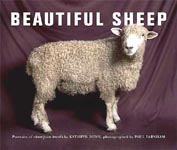
by Kathryn Dun
10" x 8 1/2" Softcover (112 pages)
2008, Ivy Press
$23.95 Canadian ($19.95 US)
For those in the know, sheep are the stars of the huge annual agricultural shows, as they parade their polished hooves and oiled horns. Swathed in fleeces expertly trimmed and coiffured to accentuate their finer points, Beautiful Sheep is a testament that skillful shepherds can create unique and living works of art.
There are a great many breeds of sheep, that for centuries provided income from their wool -- thus today's versions are able to produce long heavy fleeces. Likewise, those sheep used primarily for their meat were bred and developed to graze the harsh upland and hill territories well-suited for those climates.
All of these breeds are showcased, as never before, in the pages of this collector's item. No longer will the gentle ovine be reduced to catch phrases about "the black sheep of the family" or "the wolf in the sheep's clothing" -- but now can be appreciated and admired as stunning creatures. A beautiful pictorial of sheep -- arranged by breed, with geographical and historical information to complement the images -- immaculately presented as stars of the catwalk, the best of the show. The result is an unusual and totally charming book.
This unique gift book is destined to adorn coffee tables around the globe, from the most rural farm to the most urban of city barbers.
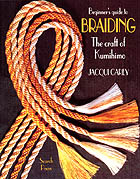
by Jacqui Carey
8" x 10 1/4" Softcover (64 pages)
2000, Search Press
NO LONGER AVAILABLE (CURRENTLY OUT OF PRINT)
Kumihimo is the ancient art of Japanese braidmaking. The craft covers a wide range of techniques made on various types of equipment.
This book looks at braiding on a Marudai (Round stand), the most popular and versatile piece of equipment in use today. Working with a traditional Marudai is a delightful experience. The equipment is aesthetic in appearance, feel and sound and the gentle rhythm of the repeated moves has a soothing quality.
Kumihimo is an accessible craft. Easy-to-make alternative equipment allows anyone to have a go. This book sets out to demonstrate that Kumihimo does not have to be complicated to be beautiful. Kumihimo braids are often made with many bobbins following complex sets of moves. Yet simple sequences of moves can provide an array of stunning results.
In this book just six sets of moves are shown, each one creating a distinct type of braid. In this colourful book, the author provides a fresh approach to Kumihimo with clear step-by-step photographs to guide the beginner through six projects which show how to make a variety of different braids. There are tips on what equipment to use and advice on how to develop the projects, using a variety of patterns, colours and textures, to create over 70 other braids. The finished braids can be used to make a range of stunning curtain ties, cords, bracelets, necklaces and fashion accessories.
Other works on Kumihimo by this author include: Beads & Braids, Braids and Beyond, Chinese Braid Embroidery, Creative Kumihimo, Round the Twist, Samurai Undressed and 200 Braids to Twist, Knot, Loop or Weave as well as: Braids: 250 Patterns from Japan, Peru & Beyond, Kumihimo: Japanese Braiding, Making Kumihimo: Japanese Interlaced Braids, Kumi Himo: Techniques of Japanese Plaiting and Kumihimo - Japanese Silk Braiding Techniques by other authors.
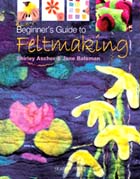
by Shirley Ascher & Jane Bateman
8" x 10 1/4" Softcover (80 pages)
2006, Search Press
$23.95 Canadian ($19.95 US)
Handmade felt is a wonderfully versatile material - you can create anything from sumptuous wallhangings and cushions to shaped and sculpted items, and all from a kitchen sink!
Hugely inspirational and instructive, The Beginner's Guide to Feltmaking shows you how to magically transform wool fibres into felt, and in the easy-to-follow, step-by-step projects you will learn how to combine different colours and textures so that, ultimately, you can create your own, unique designs.
This book is indispensable for anyone working in the world of art, gifts or textiles. It is illustrated in chapters using an easy to follow picture format, describing in stages how raw wool is turned into that most versatile of fabrics called felt.
The materials for feltmaking are very basic and apart from merino wool and calico, the equipment can be found in most kitchens. The only work as such involves 15 minutes of hard hand-rubbing which causes the fibres and layers of wool to felt and blend, and finally bond into felted material...
There is no end to the uses to which felt can be put, and it has even been made into 3-dimensional artwork. Like any other medium you will extend your creative horizons whilst being pleasantly surprised by the results of your first felting experience. This is an excellent book.
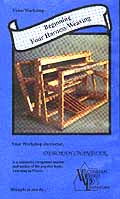
instructed by Deborah Chandler
DVD Video (86 minutes colour)
Victorian Video Productions
NO LONGER AVAILABLE
The range of weaving possibilities that a four-harness loom offers are many. There are several types of four-harness looms available. They range in size from small table-top models to large floor models. This course will introduce you to several styles of looms. After a brief review of how to wind a warp on a warping board, you will learn how to dress (thread) the loom from front to back. Then you will learn how to read a weaving draft (pattern) and weave a sample project that includes plain weave, several twill combinations, rib weave, weaving with 2 colours and an introduction to double weave.
If you have never woven before, Introduction to Weaving is a prerequisite. If you understand how to calculate warp and weft quantities, there are no further prerequisites. For material, a four harness loom (any kind) and a 12 (or 6) dent reed are needed. You will also need two colours of yarn, four ounces each, as well as scissors, heavy paper, a ruler and a shuttle. A warping board is handy, but not absolutely necessary. A detailed supply list is included, along with a weaving draft for the project.
Other works by this author include the book Learning to Weave and the video Introduction to Weaving.
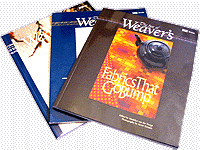
9" x 11" Softcover
XRX Books
Pricing Varies
Weaver's magazine was published for 18 years and the 44 issues produced contained many wonderful articles covering weaving techniques, projects and other relevant subjects. The publisher, working with the former editor of the magazine, Madelyn van der Hoogt, have put together a series of article compilations on a number of subjects. These Best of Weaver's books are an excellent resource for both beginner and experienced weavers and some also contain articles reprinted from the Prarie Wool Companion, another earlier weaving magazine.
The current list of books in the series are:
The publisher has also indicated that, in the future, other volumes will be added to this series covering such topics as: "Summer and Winter & Beyond", "Pique" and "Networked, Advanced and other Fancy Twills". Keep checking our site for more information when these books are published.
Note that if you are trying to organize your collection of Weaver's magazine, we also have the Weaver's Super Index 2000 which is a complete index to the magazine.
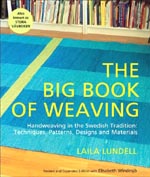
by Laila Lundell
8 1/2" x 9 1/4" Hardcover (269 pages)
2008, Trafalgar Square Books
NO LONGER AVAILABLE (CURRENTLY OUT OF PRINT)
Originally published in Swedish as "Stora Vavboken", this is the Revised and Expanded Edition of the classic with Elisabeth Windesjo.
Few things capture attention like the weave of a beautiful fabric. Whether it decorates the human form, frames a window, or warms a floor, it serves not only to soothe, excite, cool or invite via color, pattern and shape.
Creating illusion and inciting emotion with handwoven fabric is a skill that anyone can learn. Though the idea of working a loom and planning your own weave may initially seem over whelming, Laila Lundell's wonderful book The Big Book of Weaving (Stora Vavboken) makes it easy. Meticulously written as an educational and study tool for weavers of all levels, and now modernized and - for the first time in the English language, her book provides the practical, step-by-step guidance you need as you explore this delightful age-old craft.
Whatever your weaving background, you will find a comfortable place to begin - from the tools of the trade to the finer points of weave structure; from the basics of reading and designing drafts to details of traditional and modern Swedish weaving techniques. Over 40 stunning projects in vibrant colors are organized as a comprehensive "course", with each project building skills upon those you learned in the last. You will find detailed instruction, from planning to execution, for weaving popular items such as towels, rugs, pillows, curtains, bags, scarves and blankets, with tips along the way for creating your own variations.
The list of projects in this book include: "The First Practice Weaving", "Kitchen Towels with Small Blocks", "Band for Towel Hanging Loop", "Striped Kitchen Hand Towels", "Twill Rag Rug", "Striped Pillows", "Color-Effect Mohair Throw", "A Small Alpaca Throw", "Small Reverse-Treadled Rag Rug", "Cord-Striped Bags", "Checked Fabric", "Long Table Runners in Rep Weave", "Large Checked Rep Rug", "Rosepath Band", "Cotton Summer Curtains", "Bags with Bead Panels", "Large Alpaca Shawl", "Decorative Rosepath Weaving", "Boa with Rya Knots", "Slit Rya for a Bench", "Dice-Weave Pillow", "Double Width Throw", "Decorative Weaving with Paper Yarn", "Paper Yarn Screen", "Warp-Printed Fabric", "Half-Linen Mats", "Inlay Rag Rug", "Old-Fashioned Weaving", "Rag Rug x 2", "Bathroom Mats", "Alpaca Scarf", "Four Decorative Sample Strips", "Transparent Interior Furnishing Fabric", "Furnishing Fabrics x 2", "Room Divider", "Cotton Baby Blankets", "Linen Table Runners and Hand Towels", "Coordinated Furnishing Fabrics", "Colorful Pillows", "Picnic Blanket" and "Woolen Baby Blanket".
The authors expert instruction gleaned from a lifetime of loom-time is bound to build a substantial foundation of weaving know-how within first timers, as well as hone and solidify the veteran's ever-expanding skill set. Masterfully interwoven with hundreds of templates, charts, sequential drawings, and color photos, her comprehensive tutorial, like all her designs, leaves a lasting impression certain to inspire.
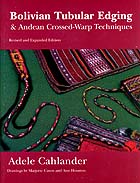
by Adele Cahlander
8" x 11" Softcover (33 pages)
1994, Dos Tejedoras
NO LONGER AVAILABLE (CURRENTLY OUT OF PRINT)
The author brings to fibre artists another handful of information on Andean weaving/braiding techniques. Crossed Warp edgings, or ribetes, traditional decorative finishes for Andean textiles, are fun to make using the finger-manipulated techniques described in this monograph. Use them for bands and cords, or as trims that you can apply as you weave! Instructions for 12 varieties of bands in Part One include diagrams, line drawings and photos. The diagrams make some complicated moves manageable. Two exotic band constructions from pre-Columbian textiles are featured in Part Two for those who like to experiment.
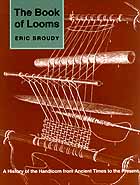
by Eric Broudy
8 1/2" x 11" Softcover (176 pages)
1979, University Press of New England
NO LONGER AVAILABLE (CURRENTLY OUT OF PRINT)
The handloom - often no more than a bundle of sticks and a few lengths of cordage - has been known to almost all cultures for thousands of years. Eric Broudy places the wide variety of handlooms in historical context. What influenced their development? How did they travel from one geographic area to another? Were they invented independently by different cultures? How have modern cultures improved on ancient weaving skills and methods?
Broudy shows how virtually every culture, no matter how primitive, has woven on handlooms. He highlights the incredible technical achievement of primitive cultures that created magnificent textiles with the crudest tools and demonstrates that modern technology has done nothing to surpass their skill or inventiveness.

by Eleanor Best
Data CD (PC/Mac Compatible)
2005, Eleanor Best
NO LONGER AVAILABLE (CURRENTLY OUT OF PRINT)
This CD is PC/MAC compatible and contains all of Eleanor Bests' weaving books including: New Weaves, Shadows, Patterns for Weaving 1, Patterns for Weaving 2, Combo 16, Combo 24 (includes the original Crepes, Diamonds, Gems and Twills books for both Combos), Donat's Weaving Patterns for Color, Patternland, Dictionary of Weaves, Motifs for Weaving and Ideas Textile Designs.
The CD includes a complete PDF copy of each book (with colour pictures) that can be read on any PC or Mac using Adobe Acrobat (Installer included on CD) plus all of the drafts in WIF format which can be used for weaving with a Computer-Dobby loom. For more information on the WIF format and the programs required to use the files Click Here.
This CD holds a phenominal collection of over 7,500 weaving drafts from 2 to 32 shafts to provide the handweaver with a lifetime of projects and inspiration.
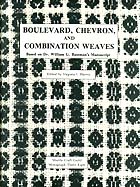
edited by Virginia I. Harvey
8" x 10 1/2" Softcover (93 pages)
1987, Shuttle-Craft Books
NO LONGER AVAILABLE (CURRENTLY OUT OF PRINT)
This is Shuttle Craft Guild Monograph Thirty-Eight
Dr. G. Bateman spent his retirement years weaving sample, first on an inkle loom, then on an eight-harness Missouri table loom. He progressed through Inkle Weaves, Overshot, Twill, Crackle, Summer and Winter and other established techniques to variations on these weaves, and finally to the discovery of new weave systems. The culmination of his work was a manuscript that documents his weaves.
This is the 4th volume in a series that reproduces the contents of Dr. Bateman's manuscript documenting his work in weaving samples. These have been reproduced in 6 monographs by the Shuttle-Craft Guild with this volume being Monograph Thirty-Eight. The other 5 volumes of Dr. Bateman's work are titled: Bateman Blend Weaves, Extended Divided Twill Weaves, Extended Manifold Twill Weaves, Multiple Tabby Weaves and Park Weaves.
In these monographs, Dr. Bateman's text has been printed with no omissions, changes or alterations. His text, which is printed on a gray background, precedes the related text prepared by the editor. The only part of his manuscript that has been rewritten is the wefting directions. The information is the same, but the method of presentation has been changed to a more conventional form of tie-up and treadling. Missing samples were rewoven following Dr. Bateman's directions and using the choice of materials he suggested. The document is illustrated with treadling and tie-up diagrams as well as black and white pictures of the samples.
Click Here for a complete list of the monographs in the Shuttle-Craft Guild series.
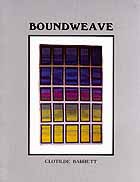
by Clotilde Barrett
8 1/2" x 11" Softcover (91 pages)
1987, Arana Press, Inc.
NO LONGER AVAILABLE (CURRENTLY OUT OF PRINT)
Boundweave is a book that explores the design potentials of twills, twill deriviatives, and some basic two-tie block weaves. The technique of boundweave produces weft-face fabrics with pattern floats over two or more threads and is suitable for rugs, tapestries, and a variety of other fabrics.
Most of the designs discussed can be woven on a 4-shaft loom. The patterns are controlled by the draft and by the colour selections of the weft. The principle of shaft switching is included, since shaft switching greatly increases the design potentials for 4-shaft boundweave. Included in the book are explorations of the design possibilities of 3-, 6-, and 8-shaft drafts, tapestry and dye techniques, and coloured photos that display boundweave projects by contemporary weavers.
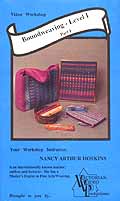
instructed by Nancy Arthur Hoskins
DVD Video (111 minutes colour)
Victorian Video Productions
NO LONGER AVAILABLE
Boundweaving - Level I teaches you how to design, draft and weave those interesting and intriguing weft-faced patterns and figures formed with "boundweaving" techniques. You will learn how one threading 'rosepath' - 1,2,3,4,3,2,1,4 - can create an infinite variety of designs by varying the tie-up, treadling, and colour order of the wefts. The three sample projects woven could become an elegant evening purse in silk or pearl cotton, a casual clutch in cotton or wool, or an eyeglass case. The same projects could be enlarged for pillows or even framed wall pieces. The boundweaving theory and weaving techniques learned and practiced will prepare you for further explorations with the weft-faced weaves used in rug weaving.
If you are new to weaving, the Introduction to Weaving video is a prerequisite to this course. If you have woven before, there are no prerequisites, but you should have a basic understanding of drafting and weaving plain weaves or twills. For materials, a four shaft (jack or rising shed preferred) , cotton rug warp, and four compatible colours of medium weight weft yarn. A detailed list of materials, sett suggestions, threading draft, treadling instructions, finishing instructions and designs are included in the cassette packaging.
The author has also written Universal Stitches for Weaving, Embroidery and Other Fiber Arts and Weft-Faced Pattern Weaves - Tabby to Taquete.
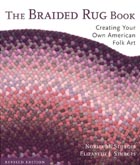
by Norma M. Sturges & Elizabeth J. Sturges
8 1/2" x 10" Softcover (128 pages)
2006, Lark Books
NO LONGER AVAILABLE (CURRENTLY OUT OF PRINT)
Learn a Time-Honored American Folk Art Tradition
A braided rug is an object of beauty, with the unmistakable warmth, richness of texture, and depth of color that only wool can deliver. Newly revised and expanded, this indispensable guide provides an easy approach to learning this enduring craft and includes several appealing color plans to make. Detailed, easy-to-follow instructions are given for a subtly shaded circular rug, a heart-shaped design that will help you to gain experience in creating a balanced, symmetrical form, a lovely five-strand rug that's new to this edition, and more. Your work will be cherished as an heirloom and passed on from one generation to the next.
This beautiful book provides a new generation with an easy-to-follow approach to the enduring American craft of rug braiding. You'll learn how to plan a rug, what weight wool to use, how to recycle old wool, how to care for braided rugs, what tools you need to get started - and much more. Instructions, illustrations, and row-by-row colour plans are provided for braiding an oval, a circle and a heart. Plus there are colour plans for braiding 16 other attractive rugs, along with numerous tips and techniques to help you create what is sure to become a family treasure! For inspiration, the book also features the work of some of this country's most talented braiders.
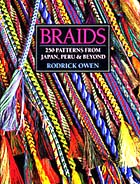
by Rodrick Owen
8 1/4" x 11 3/4" Softcover (112 pages)
2004, Lark Books
NO LONGER AVAILABLE (CURRENTLY OUT OF PRINT)
A comprehensive guide to all stages of braiding on the marudai. It also has a system of making braids on cardboard, which is excellent for school work, in a math's programme linked to geography and history. Step by step diagrams show the making instructions for a wide variety of patterns and use of fibres.
The ancient and fascinating art of rope braiding is now accessible to everyone, thanks to Rodrick Owen's wonderfully straightforward explanation of the techniques. Accompanied by drawings and beautifully photographed examples in full colour, more than 50 projects incorporating 250 patterns are included.
Other works on Kumihimo by this author include: Kumihimo: Japanese Braiding, Making Kumihimo: Japanese Interlaced Braids as well as: Beads & Braids, Beginner's Guide to Braiding - The Craft of Kumihimo, Braids and Beyond, Creative Kumihimo, Kumi Himo: Techniques of Japanese Plaiting, Kumihimo - Japanese Silk Braiding Techniques and Samurai Undressed by other authors.
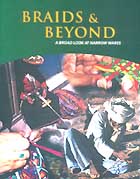
by Jacqui Carey
8 1/4" x 10 3/4" Softcover (56 pages)
2003, Carey Company
$23.95 Canadian ($19.95 US)
This attractive book was produced to go with the Braids & Beyond exhibition. I caught up with this travelling exhibition at the Bowes Museum in Barnard Castle, and found it to be splendidly displayed in that fine museum. It was a revelation to see such a wide range of uses for braids, and of techniques for making them.
This book is not intended as a catalogue of the exhibition (though it does include beautiful photographs of many of the exhibits), but gives a useful introduction to braid-making techniques. A feature of the exhibition was a table set up for visitors to try out some of these techniques for themselves: that is followed up in this book, which has How to make, examples or in action views, at the end of each section; illustrated by excellently clear photographs or diagrams.
At the exhibition table I made a complete mess of loop manipulation, but had no problems producing a satisfactory braid after a few minutes sitting quietly with the diagrams in the book, and have since been inspired to try out most of the other techniques that are so well described. It was a fine exhibition, and this is a good, useful memento of it. It is worth getting by anyone who wants an overview of braiding techniques, and a hands-on trial of many of them. (Pat Denne - Gwynedd Guild of Weavers Spinners & Dyers).
Other works on Kumihimo by this author include: Beads & Braids, Beginner's Guide to Braiding - The Craft of Kumihimo, Braids and Beyond, Chinese Braid Embroidery, Creative Kumihimo, Round the Twist, Samurai Undressed and 200 Braids to Twist, Knot, Loop or Weave as well as: Braids: 250 Patterns from Japan, Peru & Beyond, Kumihimo: Japanese Braiding, Making Kumihimo: Japanese Interlaced Braids, Kumi Himo: Techniques of Japanese Plaiting and Kumihimo - Japanese Silk Braiding Techniques by other authors.
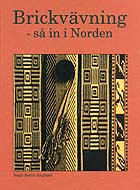
by Sonja Berlin Englund
7 1/2" x 10 1/4" Hardcover (104 pages)
1994, Brickvavnad
NO LONGER AVAILABLE (CURRENTLY OUT OF PRINT)
Note: This book is written in Norwegian but includes a 30 page booklet with the complete translation.
This book is subtitled "Tablet Woven Bands - How to Make them - What For?" which pretty well sumerizes the contents. The author has writen a complete guide to Tablet or Card Weaving with an emphasis on the techniques and designs found in the Nordic regions of Europe.
The book begins with a historical outline of Tablet Weaving with specific sections on Denmark, Norway, Iceland, Finland and Sweden and then provides complete instructions on weaving with two to six holed tablets. This includes information on warping, using a wide range of fibres as well as an explanation of the warping and weaving process.
After explaining the basics, the author provides a number of illustrated sample bands and then goes on to look at a number of variations and applications including: Stocking Stitch Bands, Apron Ties, Reins, Telemark Bands, Belt Bands, Cowberry, Relief Bands (Missed-hole Technique), Cabling (Warp Transposition), Icelandic Double Cloth, Finnweave, Double-faced Weft, Egyptian Diagonal and Brocading/Weft Patterning. The author also covers subjects like Tablet Weaving on a Gravity Tensioned Warp, Six Hole Tablet Weaving, Tablet Weaving for Children and provides a full Glossary of Tablet Weaving Terms translated into english.
This is a wonderful book on card/tablet weaving with a unique Nordic focus. It is extensively illustrated with colour and black & white photographs of woven examples, threading diagrams and pictures showing the technique.
CLICK TO SEE OUR TABLET WEAVING CARDS AT A VERY AFFORDABLE PRICE!
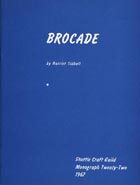
by Harrirt Tidball
8" x 10 1/2" Softcover (50 pages)
1968, HTH Publishers
$11.95 Canadian ($9.95 US)
Shuttlecraft Guild Monograph Twenty-Two
Patterns and decorative color effects can be formed manually in plain weave fabrics through extra wefts inserted into sheds or caught under warps and floated over the surface for limited distances. For such patterns the basic characteristics of the fabric are determined by the warp and weft materials, their densities and relationships, and are not altered in most cases by the supplementary weft patterning.
There are two main types of patterning with added wefts. In one, the pattern yarns are regionally inserted. They extend only across a single pattern or color area and turn back on themselves ath the pattern's outside limits. Regardless of the technical means for handling the extra wefts, this method is known as brocading, the pattern yarn is called brocaded weft, and the fabric is brocade. The wefts are discontinuous and are superficial additions to the fabric, entered during the weaving to create pattern.
The other type of patterning employs a supplementary weft which extends across the entire web, selvage to selvage, interlacing with it as needed to form the desired design on the plain weave foundation. There is no overall term for designating this type of supplementary weft patterning. Therefore, among handweavers, the weaves are usually known as pick-up weaves, a method name describing the picking up of warp threads on a stick to form a pattern shed.
In this book, the author studies Brocade by first looking at the tools and methods used to create the effect. She then studies specific areas such as Brocade Inlays, Float Overlay Brocade, Opposites Brocade, Overlay-Underlay Brocade, Wrapped Brocade, Bouquet Brocade, Combination Brocades and Brocade Spots.
She then covers "Lance" or Pick-Up Weaves looking at the Methods and Variables involved. Sections are included on "Overlay Pick-Up with Tabby", "Overlay-Underlay Closed-Shed Pick-Up", "Overlay Pick-Up with Single Tabby", "Combination Pick-Up", "Overlay No-Tabby Pick-Up" and "Underlay Pick-Up".
Like the rest of the Shuttle-Craft Guild Monographs, this is a classic analysis of a specific area of weaving by one of the foremost authorities.
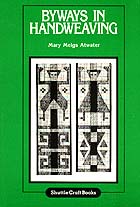
by Mary Meigs Atwater
6" x 9" Softcover (128 pages)
1988, ShuttleCraft Books
NO LONGER AVAILABLE (CURRENTLY OUT OF PRINT)
This book is a pleasure to own. In it, Mrs. Atwater describes little-known weaving techniques from various parts of the world. Instructions are given for an amazing variety of weaves. The fabrics produced by these techniques are for the most part narrow belts, bands and borders, although some of them may be adapted to wider textiles. Chapters in the book include discussions on Card, Inkle and Twined Weaving, Braiding and Knotting, Plaiting as well as Belt Weaves and other creations from areas in the world such as Peru, Estonia, Bolivia, Guatemala, Africa and Scandinavia. Clearly drawn diagrams describe the steps involved in the various techniques, and excellent photographs, in black & white, illustrate the finished pattern.
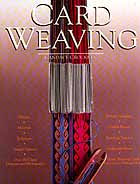
by Candace Crockett
8 1/4" x 11" Softcover (141 pages)
1991, Interweave Press, Inc.
$34.95 Canadian ($26.95 US)
With nothing more than some strands of yarn and a few simple cards with holes in them, you can easily weave fabrics of great complexity and beauty. No loom is required, and no tedious picking out of patterns by hand. This ingenious system of weaving dates back to ancient Egypt, China, and Russia; remnants of prehistoric card woven fabrics have been found in Pharaohs' tombs and Bronze Age bogs. Contemporary weavers use the technique to produce belts and bands, decorative trims, bags, wearable art, sculptural pieces, and wall hangings using sturdy woolen yarns, sleek cottons and linens, or the finest silks.
The author begins Card Weaving with a fascinating historical overview, then introduces the materials and techniques of the craft. Next, she takes the reader step by step through the basic process, including how to thread the cards and set them up for weaving, and how to turn them to produce patterns. The next chapters deal with the most exciting aspect of card weaving - designing and drafting original patterns. The range of patterns is almost unlimited, and creating them is deceptively simple. Bold geometrics, intricate freeform designs, pictorial motifs, even names and initials can be planned with nothing more than a pencil and graph paper.
Each chapter includes a wealth of finished card weavings, both ancient and modern. More than a score of pattern drafts are provided. A complete bibliography and glossary, plus a suppliers list, round out the information.
CLICK TO SEE OUR TABLET WEAVING CARDS AT A VERY AFFORDABLE PRICE!
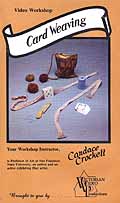
instructed by Candace Crockett
DVD Video (97 minutes colour)
Victorian Video Productions
NO LONGER AVAILABLE
In this course you will learn the basic techniques of card weaving, how to measure the warp, thread the cards, set up and weave patterned bands and how to stitch bands together to form larger fabrics. This weaving technique involves simple tools, cardboard cards and yarn. Once the pattern is determined and the cards are threaded, the weaving goes very quickly. The technique offers unique richness of pattern and texture and produces sturdy and decorative fabrics.
This course involves two projects; the first will be a band which can be used as a belt, neck piece, or strap. The second project involves a completely different warping and weaving process and produces numerous patterns which will be woven into four bands which can be stitched together to form a tote bag or purse. In addition to the pattern draft provided, you will learn how to design and draft patterns and how to translate these patterns into woven fabrics.
In order to participate, the student should have 20 Square cardweaving cards (orderable separately) and 2 sturdy C Clamps. The material needed for the first project is Cotton thread for warp in three colours (52 feet of one colour, 76 feet of the second and 55 yards for the third. For the second project the student will need Medium weight plied wool yarn in two colours (135 of light and 175 yards of dark).
CLICK TO SEE OUR TABLET WEAVING CARDS AT A VERY AFFORDABLE PRICE!
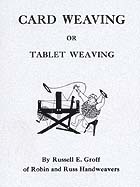
by Russell E. Groff
6 1/4" x 9 1/2" Spiralbound Softcover (47 pages)
1997, Robin & Russ
$16.95 Canadian ($13.95 US)
This small book is loaded with information on card/tablet weaving and is perfect for the beginner as well as the more experienced weaver. A full set of instructions on the card weaving technique is provided including an overview of the equipment and materials that are required. The directions are illustrated with photographs and line drawings explaining the process.
After teaching the basics, the author then provides a collection of 53 belt patterns. Each one is illustrated using a black & white photograph, and threading diagrams, colours of yarn to use and an explanation of the technique used is provided.
CLICK TO SEE OUR TABLET WEAVING CARDS AT A VERY AFFORDABLE PRICE!
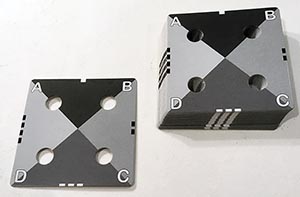
25 x Square (3 1/2" x 3 1/2")
Cardweaving Cards (4 holes)
Available at great prices with quantity discounts!
Click here for more Information
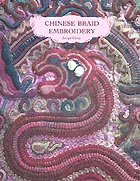
by Jacqui Carey
8 1/4" x 10 3/4" Softcover (128 pages)
2007, Carey Company
NO LONGER AVAILABLE (CURRENTLY OUT OF PRINT)
Braid embroidery is just one of the many wonderful textile traditions found in China. This book is intended as a snapshot of the technique, providing insights into its history and development, as well as a look at the situation today. Materials and equipment are considered, ranging from the made-for-purpose to household alternatives.
Step-by-step instructions give a clear guide to making the braids and the stitching methods used to apply them. This book provides the reader with a feast of colour and information!
Other books by this author include: Beads & Braids, Beginner's Guide to Braiding - The Craft of Kumihimo, Braids and Beyond, Creative Kumihimo, Round the Twist, Samurai Undressed and 200 Braids to Twist, Knot, Loop or Weave.
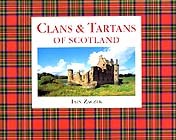
by Ian Zaczek
10" x 7 3/4" Hardcover (144 pages)
1998, Collins & Brown Limited
NO LONGER AVAILABLE (CURRENTLY OUT OF PRINT)
The roots of the closely-knit structure of the Highland communities stretches back into Scotland's Celtic past. The clan was an extended family with traditions that they guarded fiercely. The pride and loyalty which the emphasis on blood ties inspired is what made the system successful and today it is symbolized by the different tartans that the clans wear so proudly.
Clans and Tartans of Scotland illustrates the various tartans and retells many of the histories of the clans and families of Scotland from Abercombie to Wotherspoon. An introduction traces the history of the clan system and looks at tartan and the tradition of wearing tartan, including hunting, dress and regimental designs. The clans and families are then organized alphabetically with special features throughout on the major clans such as the Stuarts, Camerons, Campbells and Gordons.
In addition, there are stunning colour photographs throughout, capturing the majesty of Scotland and illustrating castles and landmarks closely associated with the clans and families
A map at the beginning of the book illustrates where many of the clans originated from and a list at the back of the book features the addresses of various clan and family associations.
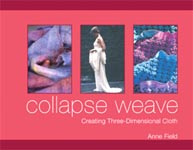
by Anne Field
9 1/4" x 7 1/4" Softcover (160 pages)
2008, Trafalgar Square Books
NO LONGER AVAILABLE (CURRENTLY OUT OF PRINT)
After striving to create flat, consistent fabrics for most of her career, Anne Field discovered a new kind of weaving that emphasised the flexibility and movement of yarns. This new method of weaving, termed Collapse Weave, started appearing everywhere she looked in museums and books - it was an ancient form of decorative weaving largely overlooked by modern weavers.
Collapse cloth is cloth that, when removed from the loom and washed, takes on an entirely different appearance as the threads draw up and create puckers.
Collapse weave can be created by contrasting yarn factors, or combining weave structures that react with each other to create ridges and hollows. The deliberately pleated and puckered fabric produced has a flexibility of movement that makes it lovely to wear, and the uniqueness of the weave means the artistry of the weaver can be seen in the cloth. As Anne says 'The hand of the maker' is evident in the fabric, making each piece created an original artwork. This is the kind of weaving that can only be created by hand, and is extremely satisfying to produce.
In this book, combinations of various weaving techniques are presented alongside photos and diagrams, providing clear instructions for sewing scarves, wraps, tops, and harem-style pants made from this fluid and unusual cloth. Instructions are clearly written and easy to understand, and the book is fully illustrated with examples of the kinds of cloth produced, and clear, easy to follow diagrams.
Additional chapters describe in detail how to warp the loom and add special effects such as double weave, supplementary warps, spaced cloth, overshot, and deflected double weave. Tips for those who want to spin their own yarn for collapse projects are also included.
This guide opens the door to an exciting form of weaving. Other books by the author include The Ashford Book of Weaving for the Four Shaft Loom.
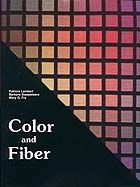
by Patricia Lambert, Barbara Staepelaere and Mary G. Fry
9" x 11 1/4" Hardcover (255 pages)
1986, Schiffer Publishing Ltd.
$59.95 Canadian ($49.95 US)
Color and Fiber presents, for the first time, a concise and accessible explanation of colour as related to fibre. Patricia Lambert, Barbara Staepelaere and Mary G. Fry have arrived at their observations through careful research and observation in their own work as artists and designers as well as through their years of experience as teachers. Anyone who carefully follows the concepts of this book from beginning to end will benefit from a treatment of the theoretical and practical aspects of the subject that is commensurate with the best college-level courses in colour available today. Color and Fiber is destined to become a standard text for those involved in structured programs, as well as for those studying independently. ---------- Gerhardt Knodel - Chairman, Fiber Department of Carnbrrok Academy of Art
Fiber artists will welcome this opportunity to learn how to use and control colour with this monumental and exquisitely beautiful book. Whether they stitch, quilt, weave, work in macrame, hook rugs, knit, crochet or experiment in mixed media, the artists will benefit from the authors' techniques for solving colour problems. This revised second edition of Color and Fiber is divided into three sections. The first section presents essential terminology, ideas and definitions about light and colour as preparation for the problems, projects and ideas which follow. Topics covered include Light, colour mixing with light, light and colorants, colour mixing with dyes and pigments, structural colours, types of light and their influence on colour, lighting and perception, the four characteristics of reflected colour, comparing colour characterisitics, afterimages and colour shifts as well as optical colour mixing.
The second section describes how light, dye and pigment work with fibers because individual fibers, yarns and fabrics differ in their response to light and colour. The ability to solve colour problems depends on the artists' understanding of the fiber's light and colour relationships. Topics in this section include: Fiber colorants, structural orientation of fibres and yarns, special methods of dye application, fibre shape affect on value, orientation, the affect of yarn surface texture on colour intensity and value as well as finishing techniques and their affect on light reflectance and colour change.
The third section presents the practical applications for the information gained in the first two sections. Besides colour mixing and special effects such as iridescence and opalescence, this section examines projects that artists or classes can do to understand colour's part in determining spatial effects, emotional impact and colour systems. Topics covered include: Optical mixing with fiber and its practical application, simultaneous contrast, negative and complementary afterimage, colour shifts, methods of reinforcing and reducing simultaneous contrast, chromatic and achromatic systems, composite colour relationships, illusion of space, spatial techniques, deep and flat space and structural colour effects. Over 140 projects are presented by the authors in ascending difficulty for use in and out of the studio to allow the reader to gain a more in-depth understanding of the concepts presented in the book.
This text is extensively illustrated using both colour and black & white photography as well as line drawings. As well as their own work , the author's have included examples from artists like Helena Hernmarck to illustrate their explanations. The book also includes an extensive index, bibliography and glossary making it an excellent reference work for any artist working with colour.
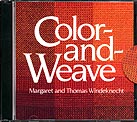
by Margaret and Thomas Windeknecht
2 x CD Set
2000, Margaret B. Windeknecht
NO LONGER AVAILABLE (CURRENTLY OUT OF PRINT)
The author has taken the original hardcover publication of Color-and-Weave (published in 1981) and has electronically reproduced it on this 2 CD set to allow you to access it through your computer. In addition to the book contents, the colour scans of samples prepared for the book are also included. Both the Table of Contents and the Index have been configured with hyperlinks to allow you to jump through the book just by clicking on an entry making it very fast to jump right to the information you are searching for.
This is an Acrobat document and Acrobat 4.0 Installers for the PC and Mac are included. The Mac requirements are that you have an Apple Mac PowerPC computer running System 7.1.2 or later as well as at least 16 MB of RAM and 75 MB available disk space on hard drive. PC users must be running Windows 95, 98, ME or NT 4.0 with Service pack or Win 2000, at least 16 MB of RAM and 75 MB available disk space on your hard drive.
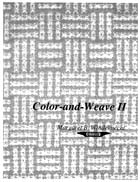
by Margaret B. Windeknecht
8 1/2" x 11" Softcover (124 pages)
1994, T. G. Windeknecht, Publisher
NO LONGER AVAILABLE (CURRENTLY OUT OF PRINT)
This is the result of 14 years of additional study since the author first published Color and Weave I (out of print since 1986). This book explores an almost infinite number of color-and-weave effects in a wide variety of weave structures including plain weave (such as log cabin, shadow weave and rep weaves), twill, block weaves, and warp-faced weaves. Also included are chapters on isolating color-and-weave effects, achieving other unusual color effects, and generating color-and-weave graphics. The book is well illustrated with a large collection of drafts and drawdowns combined with fabric samples shown in black and white.
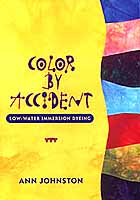
by Ann Johnston
6 1/4" x 8 3/4" Spiral Bound Hardcover (96 pages)
2004, Ann Johnston, Publisher
$30.95 Canadian ($25.95 US)
Color by Accident is designed to be used as a workbook and as a reference manual for the adventuresome.
Beginning and experienced dyers will find Color By Accident to be an inspiring guide for creating one-of-a-kind fabrics not available commercially. It includes five variations on a versatile method and 54 tested recipes. Not required are expensive equipment, dangerous chemicals or specialized studio space.
Other books teach how to repeat a method and reproduce colors. This book points the way to exploring new color combinations and to achieving fabric that will be unique and visually complex.
This book differs from other dye books by using a spontaneous approach to the subject. The small amount of water used makes dyeing easy, the recipes can be adapted to fit any schedule, no salt is required and the results are one-of-a-kind!
The author's other books include Color by Design - Paint and Print with Dye.
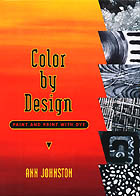
by Ann Johnston
6 1/4" x 8 3/4" Spiral Bound Hardcover (168 pages)
2001, Ann Johnston, Publisher
NO LONGER AVAILABLE (CURRENTLY OUT OF PRINT)
Color by Design shows you how to dye cottons and silks in an incredible range of colors and patterns - without changing the feel of your fabric. Using every tool imaginable - from brushes, sponges, stamps, and blocks to rollers, sprays, silk screens, and more - you will discover an endless array of techniques. Right away you will be able to create your own distinctive marks and colors, and with practice, you will create intricate designs with confidence and spontaneity.
This book is extensively illustrated with beautiful colour photographs and includes full instructions for 48 dyeing exercises as well as a list of sources for materials, a glossary and many helpful tips.
The author's other books include Color by Accident - Low-Water Immersion Dyeing.
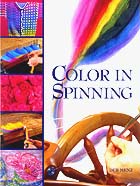
by Deb Menz
8 3/4" x 11 1/4" Softcover (240 pages)
2005, Interweave Press
NO LONGER AVAILABLE (CURRENTLY OUT OF PRINT)
Color in Spinning is a practical guide to colour for handspinners. Deb Menz offers a technically savvy yet accessible tutorial on working with colour and fibre. After a short introduction, the author presents chapters on: "Understanding color principles most useful to spinners", "Step-by-step immersion dyeing", "Painting rovings for multicolored yarns", "Blending colors and fibers with a drum carder", "Drum carding for multicolored yarn", "Producing multicolor yarn with combing techniques" and "Spinning and plying multicolored preparations". As a final touch, a gallery of 21 finished Garments, Accessories and Tapestries is presented along with Dye Worksheets, a Glossary of Dying Terms, an extensive bibliography, a source list as well as a complete index. With more than 300 beautiful colour illustrations, Color in Spinning will inspire the novice and expert alike.
The author has also written Color Works - The Crafter's Guide to Color.
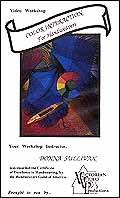
instructed by Donna Sullivan
DVD Video (60 minutes colour)
Victorian Video Productions
$25.95 Canadian ($21.95 US)
This video offers a systematic approach for applying colour principles to handwoven structures, from warp-faced to weft-faced and between. Woven examples illustrate the range of colour interactions in weaving. Yarn sequences, needle weavings and colour blankets are suggested as initial opportunities to study colour effects ranging from blending to vibrations.
This course will be even more meaningful if you are already familiar with weaving structures and colour terminology; references in both areas are suggested on the written insert. To work through all the recommended exercises, you will need: cardboard or matt board, two-sided tape, rubber cement, coloured papers, scissors, a blunt-ended needle, loom with 10-dent and 12-dent reed and a shuttle. A variety of yarns are recommended on the insert.
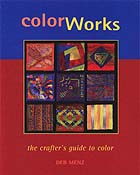
by Deb Menz
7 1/2" x 9 1/2" Hardcover Spiral Bound (133 pages)
2004, Interweave Press
NO LONGER AVAILABLE (CURRENTLY OUT OF PRINT)
We all love color - its boundless array of hues dazzles our eyes, expresses our moods, and enriches our very lives. Thanks to Deb Menz, master teacher and author of the highly respected book Color in Spinning, you can now explore colors with confidence in whatever craft medium you call your favorite.
This is the first book to bring the principles of color theory down to a practical level and apply them to knitting, spinning, weaving, surface design (including stenciling and rubber stamping), hand- and machine-embroidery, beadwork, and paper collage. Basic color concepts are presented in sections on color description, values, contrasting and complementary colors, warm and cool colors, undertones, using color relationships, and much more. But the real treat is seeing a dynamic palette of color harmonies worked up in each medium!
Color Works gives you practical, hands-on tools for using colours in nine crafts including knitting, spinning, weaving, quilting, surface design (including stenciling and rubber stamping), hand- and machine embroidery, beadwork and paper collage.
Color theory principles are demystified with clear explanations, examples, and more than 270 hand-crafted swatches that bring colour palettes to life in all nine mediums. A 32 page interactive section in the book features a pull-out colour wheel, two colour value scales and perforated hue cards which are great to use for planning, matching, and shopping for supplies.
This approach is invaluable for mixed-media artists or those who simply dabble in more than one craft. If understanding color is the bridge to creative expression, how did we ever live without this book?
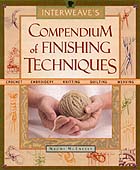
by Naomi K. McEneely
7 1/2" x 9" Softcover Spiral Bound (176 pages)
2003, Interweave Press
NO LONGER AVAILABLE (CURRENTLY OUT OF PRINT)
For the first time, an abundant collection of fabric finishing techniques is presented in a single book!
This invaluable compendium offers finishing techniques for weavers, knitters, sewers, quilters, embroiderers, crocheters, or anyone interested in the textile arts. From basic to esoteric, simple to elegant, or plain to highly decorative, these finishes can be applied to most any fabric - woven, knitted, crocheted, handmade or purchased. Each technique is clearly presented with text, illustrations and photographs of examples created in the technique. In the years ahead, this book will become your most-prized reference for all your finishing needs.
The book has two indexes, the first groups the techniques by type indicating whether they are "Edges", "Seams and Joins", "Braids, Cords a& Trimmings", "Embroidery" and "Miscellaneous". The second index groups the techniques by what discipline they are primary used in. The "Crochet" techniques covered include Bosnian Stitch, Buttonholes, Buttons (Ring, Cover, Ball and Acorn), Chain Fringe, Crocheted Loops, Corkscrew Fringe, Finger Braid, Looped Fringe, Picot Chain, Irish Picot, Mile-a-Minute Edge, Picking Up, Popcorn Stitch, Reverse Stitch, Round Cord, Simple Lace, Slip Stitch and Tassel Crocheted Crown. "Embroidery" Techniques include Arrow Tack, Attaching Lace and Other Trim, Blanket Stitch, Blind Stitch, Bound Hem, Bullion Knot, Buttonholes, Buttons, Chain Stitch, Chevron Stitch, Couching, Cross-Stitch, Duplicate Stitch, Fagoting Stitch, Fly Stitch, French Knot, Herringbone Stitch, Ladder Hem, Mitering, Monograms, Mountmellick Stitch, Overcast Stitch, Pekinese Stitch, Piping, Raised Chain Band, Rolled Hem, Satin Stitch, Scalloped Hem, Slip Stitch, Smocking and Stem Stitch.
For "Knitting" there is information on the Backstitch, Bias Bands, Bolivian Pom-Pom, Buttonholes, Darning, Finger Cord, Fringes, I-Cord, Invisible Stitch, Kitchener Stitch, Knitted Lace, Picot Turning, Pom-Poms, Pressing, Purl Turning, Rolled Hem, Spool Cord, Tassel Knitted Crown and Tassel I-Cord. "Knotting" Techniques presented include: Bullion Knot, Chinese Flower, Damascus, Phillipine, Double Wrapped Cord, Half Hitch, French Knot, Monkey's Fist, Overhand, Sennit and Square. Finally, for "Weaving" there are instructions on: Augmented Fringe, Baseball Stitch, Bound Seam, Braids, Buttonhole Stitch, Concealed Seam, Couching Join, Damascus Edge, Darning, Drawn Thread Marker, Double Wrapped Cord, Edges Done On Loom (Chain, Clove Hitch, Four-Sided Fringe, Hemstitch, Looped Fringe, Twined, Warp Tabs and Wrapped Warps), Eskimo Join, Fingerweaving Braid, French Seam, French Sennit Braid, Fringe, Half Hitch Knots, Hong Kong Seam, Invisible Join, Lacing, Needle-Woven Picot Edge, Netted Fringe With and Without Beads, Phillippine Edge, Picot Edge, Peruvian Flat Braid, Rya Join, Slentre Braid, Spool-Knitted Cord and Wrapped Edge.
This is easily the most complete book on the subject, a manditory reference book for fibre artists and a fascinating collection of techniques that you will want to try on your own projects!
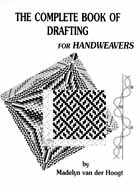
by Madelyn van der Hoogt
8 1/2" x 10 3/4" Softcover Spiral Bound (136 pages)
1994, ShuttleCraftBooks Inc.
NO LONGER AVAILABLE (CURRENTLY OUT OF PRINT)
"As a new weaver, my struggle to understand weave structures was like trying to fit together unmatched pieces of a jigsaw puzzle: twills here, overshot there, profile drafts somewhere else, and unit weaves almost nowhere. This is the book I needed. With the Complete Book of Drafting, you'll not only learn to use drafting tools - warp and weft drawdowns, warp and weft cross sections, and block profile drafts - you'll also learn how to design with pattern weaves. Under one cover find the steps for drafting and weaving any profile design in any unit weave." .... Madelyn van der Hoogt
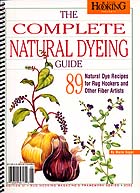
by Marie Sugar
8" x 11" Softcover Spiral Bound (80 pages)
2002, Rug Hooking Magazine
NO LONGER AVAILABLE (CURRENTLY OUT OF PRINT)
Create a Rainbow of Colour Fabrics from Plants in your Garden!
Selecting and creating your own colours is one of the most important aspects of any fibre arts project. And what's more rewarding than creating those colours from plants in your own yard or garden, or from produce you pick up at the grocery store? In this book, the author shows you how with concise step-by-step directions for 89 different dye recipes. You'll also find the techniques you'll need to create different colours from one pot of dye. You'll learn not only how to dye using a dye pot, but also with your oven - or without using heat at all!
The book begins with a chapter on the history of Natural Dyeing and then provides some insight into the dyeing process itself with sections on Mordants and Assistants along with instructions on creating a Dye Record to document the process. After this introduction to the process it is on to the dye recipes. The author groups them into two chapters: "19 Mail Order Natural Dye Recipes" and "70 Recipes for your Garden or Grocery Store". Each recipe includes a colour swatch showing the expected colour, a list of specific characteristics, the history of the dye and a detailed recipe of how to produce it. A Gallery of 19 Hooked Rugs coloured using the dye recipes in this book plus a list of Mail Order Suppliers, a Bibliography and a Good Glossary of Dyeing terms completes this book. In addition, to make it easy for the reader to find the exact recipe - or colour - that they are looking for, the author has even included a complete table of contents and a handy "Dyes-by-Colour" index.
The ability to dye naturally is an indispensable skill in any fibre artists repertoire. Thanks to this book, dyeing naturally is easier than ever before!
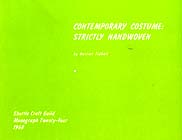
by Harriet Tidball
10 1/2" x 8" Softcover (44 pages)
1963, The Shuttle Craft Guild
$12.95 Canadian ($10.95 US)
This is Shuttle Craft Monograph Twenty-Four and describes a series of Handwoven garments produced by artists who have woven material and then taken the next step fashioning the material into a number of garments. A total of 20 clothing ideas are shown in black and white pictures and are accompanied with construction information as well as weaving hints. From Nell Scott, the author provides information on a Poncho, Sweater, Coat and Cape design while from Rosalind Berlin a Coat Dress, Dress in Two Pieces, Oval Poncho, Peter Pan Dress, Dinner Dress, Party Dress and a Cape/Coat for Winter Sports are highlighted. Finally from Tonya Rhodes a Tunic, Dress, Evening Skirt, Dress Pajamas, Outdoor Dress, Winter Costume, Sweater Dress, Bolero Suit and Fringed Coat are described. This book provides a source of inspiration and ideas on how to produce wearable handwoven fashion.
Click Here for a full list of the Shuttle-Craft Guild Monographs currently available.
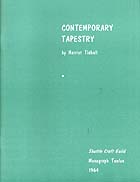
by Harriet Tidball
8" x 10 1/2"Softcover (46 pages)
1964, HTH Publishers
$12.95 Canadian ($10.95 US)
Shuttle Craft Guild - Monograph Twelve
This monograph provides an overview on contemporary tapestry weaving. It starts with an explanation as to the reason for the revival in this form of weaving and then presents a description of the basic tools required including: looms, warp & weft materials, bobbins and beaters. The book then goes on to explain the warping and weaving process and describes the most common techniques including: Kelim, Dovetailed, Locked and Interlocked Wefts, Diagonals, Outlines, Spots, Hatchings, Shadowing, Shadings and Modeling. After a short section on finishing and hanging tapestries a set of contemporary works are analyzed. The work concludes with a set of lessons on Tapestry Weaving and Composition by Eva Anttila of Finland who many credit for the revival of contemporary tapestry weaving in the early 1920's.
This is an excellent overview for those considering weaving a Tapestry and who want to know more about the subject. This book is illustrated with many black & white photographs and line drawings.
Click Here for a full list of the Shuttle-Craft Guild Monographs currently available.
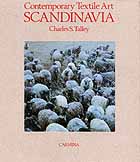
by Charles S. Talley
8 1/2" x 9 1/2" Hardcover (200 pages)
1982, Carmina
NO LONGER AVAILABLE (CURRENTLY OUT OF PRINT)
Scandinavian textile art has a long tradition. It is perhaps the one art form in the Nordic countries today that most clearly rests on a history of imagination and techniques that descends directly from the Viking era and the Middle Ages. It has its roots in an agrarian society which had experienced essentially no major cultural uphevial until after World War II.
This has made it possible for contemporary textile artists in Scandinavia to have a natural home among textile techniques and patterns which would otherwise have been lost long ago. It has made it possible for them to develop their textile work with the stamp of a tradition which in itself forms a kind of backgrond. Even when one considers the are of highly advanced textile experimentation, the work is firmly grounded. In each and every one of the Scandinavian countries there is a vital link to native traditions.
Within Scandinavia, textile art has an exceptionally strong standing, although it is not especially well-known in the rest of the world. Consequently, I think it is most worthwhile that the American textile artist and author Charles Talley has investigated this subject matter in order to preserve it to an American and International public. His travel to the Nordic countries has been a kind of voyage of discovery. He has been willing to go to even the most out of the way regions in his search. I must say that he has found something very important. He has not only found particular artists in their creative environments, but has also discovered something of the soul of Nordic textile art expression.
From the books Forward by Beate Sydhoff - Director, Stockholm City Cultural Administration - Fine Arts Department
In this book the author documents his exploration of textile art in Scandinavia by profiling 33 textile artists and their creations. The artists are grouped in sections by country and in each he provides a background description of the textile tradition in that country as well as a collection of works by selected artists.
The list of artists profiled by country are: Norway - Hannah Ryggen, Synnove Anker Aurdal, Brit H. Fuglevaag, Kjell Mardon Gunvaldsen, Anne Marie Komissar and Gro Jesson; Sweden - Handarbetets Vanner, Edna Martin, Elisabet Hasselberg-Olsson, Hans Krondahl, Sandra Ikse, Marja Graset Andersson, Maria Triller, Elsa Agelii and Textilgruppen; Finland - Dora Jung, Irma Kukkasjarvi, Maija Lavonen, Irja Mikkola, Kirsti Rantanen, Marimekko and Vuokko Eskolin-Nurmesniemi; Denmark - Margrethe Agger, Jette Gemzoe, Annette Juel, Jette Nevers, Ruth Malinovski and Helle Kastrup-Olsen; Iceland - Asgerdur Buadottir, Hildur Hakonardottir, Gudrun Audunsdottir and Ragna Robertsdottir.
This book is lavishly illustrated with over 150 beautiful colour photographs of the artist works.
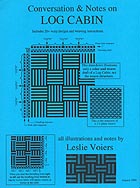
by Leslie Voiers
8 1/2" x 11" Spiral Bound Softcover (47 pages)
1999, Water's Edge Weaving Studio
$15.95 Canadian ($12.95 US)
NO LONGER AVAILABLE (CURRENTLY OUT OF PRINT)
These notes are a useful tool for study groups or for the weaver wishing to explore the world of Log Cabin in the peace and quiet of their own weaving room. The document was created as a compilation of notes, illustrations and drafts that form the handouts for the author's workshop on Log Cabin. Crisp diagrams coupled with explanatory text help the reader understand this fascinating pattern structure and the 25 clearly explained projects the author has put together allow them to experience it for themselves.
Other monographs by Leslie Voiers include: Lace Weaves Portfolio, Plain Weave is Anything but Plain and Winding Multi-Colored Warps with a Warping Paddle.
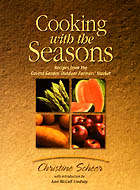
by Christine Scheer
6" x 8 1/2" Spiralbound Softcover (149 pages)
2002, Covent Garden Market Corp.
NO LONGER AVAILABLE (CURRENTLY OUT OF PRINT)
When you love to cook and enjoy good food, nothing tops the pleasure of discovering the freshest produce available. Cooking with the Seasons shows how to make the most of the amazing diversity of foods produced in Southwestern Ontario. Containing more than 100 recipes from the farmers, chefs and other culinary experts associated with London's Covent Garden Outdoor Farmers' Market, this straight-from-the-soil guide makes it easy to base meals around the freshes products of the season. It also includes some fun recipes to make with your children.
Established in 1845, Covent Garden Outdoor Farmers' Market is one of London, Ontario's most treasured cultural landmarks. This public market reintroduced an open-air farmer's market after a major redevelopment in the late 1990s. Now operating on the Market's public square during the growing seasons, the twice-weekly Outdoor Farmers' Market features local products sold directly by area farmers.
The book's author is a chef who has the good fortune to be married to a farmer. This marriage of food and farming has led to a deep appreciation of local in-season produce. Christine has taught cooking classes in London as well as courses at Fanshawe College and, for a number of years, was a partner in a London-based catering business. She completed an apprenticeship at London's noted Black Swan Cafe' and an externship at the internationally acclaimed Cafe Beaujolais in California.
$2.00 from the sale of this book will be donated to the London Food Bank.
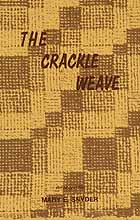
arranged by Mary E. Snyder
5 1/2" x 8 1/2" Softcover (157 pages)
1989, Robin & Russ Handweavers
$15.95 Canadian ($12.95 US)
42 complete projects with worksheets giving threads used, treadling, threading, and all necessary details. This is the revised edition and includes 90 projects with complete worksheets.
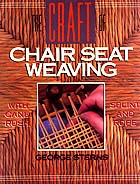
by George Sterns
8 1/2" x 11" Softcover (159 pages)
1996, Interweave Press
NO LONGER AVAILABLE (CURRENTLY OUT OF PRINT)
George Sterns shares all of the skills he has acquired, after repairing more than 10,000 chairs. He knows his subject well, and like a good teacher, he passes on what he's learned in a no-nonsense manner that instructs as only one with experience can. Included are clear, step by step instructions for weaving with cane, rush, rope, and splint, along with seasoned advice on working with traditional techniques, materials and finishes. There is even an 8-page colour section with pictures of attractive completed chairs.
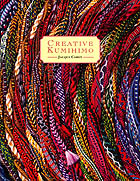
by Jacqui Carey
8 1/4" x 10 3/4" Softcover (100 pages)
1994, Devonshire Press Ltd.
$47.95 Canadian ($39.95 US)
Braid making can be found throughout the world, but as with many other subjects the Japanese braids have a distinctive character of their own. Kumihimo has been an integral part of the Japanese culture for many centuries encompassing both qualities of function and decoration. These braids were used in all walks of life, but notably in the construction of Samurai Armour.
The word Kumihimo covers a wide range of braiding techniques using various types of equipment. This book concentrates on Braids made on a Marudai; a simple device that is surprisingly sensitive and versatile.
There are many reasons why making Kumihimo is so appealing. The equipment used is aesthetic in both appearance and its tactile qualities. Coupled with this, the braiding process with its gentle, repetitive moves has a calming therapeutic effect on both observer and practitioner. Working different sequences of moves creates a variety of harmonious rhythms, each one producing a specific braid structure.
Over 50 structures are explained in this book. Different patterns on these structures can be achieved by rearranging the starting positions of the coloured threads. Examples are shown and the unique drafting system enables the user to design and discover a myriad of other possibilities.
Alterations in structure, texture, colour and pattern create an infinite diversity of braids. This enables the braid to be created specific to requirements; be it for the braid alone or to compliment other mediums. This is further illustrated by various design concepts in the final chapter. The simplicity of Kumihimo makes it accessible to all whilst its potential to expand provides endless fascination!
This gloss laminated, sewn bound book is illustrated using colour photographs and charts throughout. It has easy to read diagrams of equipment, techniques etc. There is a whole chapter devoted to a variety of braid finishes. The final chapter looks at design ideas and creative effects that can be used to bring this traditional technique into the 21st century, opening up fascinating possibilities for the world of Textiles; both Fashion and Furnishing and beyond!
Other works on Kumihimo by this author include: Beads & Braids, Beginner's Guide to Braiding - The Craft of Kumihimo, Braids and Beyond, Chinese Braid Embroidery, Round the Twist, Samurai Undressed and 200 Braids to Twist, Knot, Loop or Weave as well as: Braids: 250 Patterns from Japan, Peru & Beyond, Kumihimo: Japanese Braiding, Making Kumihimo: Japanese Interlaced Braids, Kumi Himo: Techniques of Japanese Plaiting and Kumihimo - Japanese Silk Braiding Techniques by other authors.
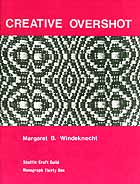
by Margaret B. Windeknecht
8" x 10 1/2" Softcover (64 pages)
1978, HTH Publishers
NO LONGER AVAILABLE (CURRENTLY OUT OF PRINT)
The primary focus of this monograph is to encourage the weaver to create original Overshot threadings. The many traditional Overshot patterns, so well-documented elsewhere will not be included here.
In Creative Overshot, the reader will be shown several different was to approach the design of an Overshot pattern. The first step will be the exploration of the structure of the weave and its relation to twill. This will be followed by the study of several innovative approaches to creating an Overshot threading, beginning with the expansion of a twill weave, and followed by the creation of a basic pattern shape on squared paper, using first a breakup of space and then a linear approach to the design. The traditional treadling sequences will be explored and will be followed by variations and innovations in treadling. The use of Overshot as a laid-in pattern will be included. Finally, the potential of Overshot as an eight-harness threading will be explored. This is Monograph Thirty One from the Shuttle Craft Guild series.
Click Here for a full list of the Shuttle-Craft Guild Monographs currently available.
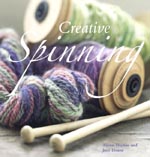
by Alison Daykin & Jane Deane
9" x 9 1/2" Softcover (112 pages)
2007, Lark Books
$19.95 Canadian ($16.95 US)
Needleworkers no longer have to settle for what's available at the local yarn shop! Alison Daykin and Jane Deane, who have decades of experience spinning, weaving, and dyeing, show how easy it can be to create personalized and gorgeous skeins of one-of-a-kind fibers.
Designed for complete beginners, this attractive guide offers 30 beautiful projects that teach a repertoire of skills on both the hand spindle and spinning wheel. It starts with simple, basic combing, twisting, plying, and finishing, then goes on to offer a primer on working with fibers.
All the chapters are organized by yarn type, including short wool and down, medium fine wool, long wool and lustre, hill and mountain, rare wool, animal hair, silk, and vegetable fiber.
The first part of the book explains all the general techniques that the reader will need, and shows how to put them into practice through step-by-step illustrations. It offers an overview of the fibers the reader is likely to work with, before moving on to the preparatory techniques of carding and combining fibers.
After learning how to prepare fibers there are instructions to get actually spinning, using a simple spindle and wool fleece. The instructions then move on to describe the various types of spinning wheel and show how to use a wheel.
Once the reader is familiar with spinning "singles yarn", the first yarn produced from fibers, you can progress to two-plying and three-plying yarn. Further techniques follow to enable the reader to construct and spin a variety of fancy yarns, including several silk spinning methods.
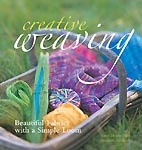
by Sarah Howard & Elisabeth Kendrick
9" x 9 1/2" Softcover (112 pages)
2007, Lark Books
NO LONGER AVAILABLE (CURRENTLY OUT OF PRINT)
The timeless craft of weaving is experiencing a resurgence of interest-and this colorful guide, featuring 30 spectacular fabric designs, shows just how easy it is to learn and how enjoyable it can be to do.
Follow a thorough tutorial in the basics, complete with beautiful hand-drawn illustrations that lay out how to work with a rigid heddle loom. Then try a variety of weaving styles, from traditional to playful, from subtle variations in color to bold experiments with form. Work with traditional fibers or play with unusual materials such as recycled fabrics, feathers, foil, and even plastic bags.
A gallery showcases how 12 weaves can be transformed into functional objects, including throws, cushions, shawls, and scarves.
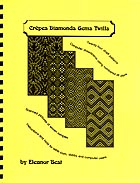
by Eleanor Best
8 1/2" x 11" Spiral Bound Softcover (200 pages)
1998, Bestudio
NO LONGER AVAILABLE (CURRENTLY OUT OF PRINT)
This book of patterns and hints for weavers with 24 shaft (harness) looms groups scanned pictures of woven samples with the computer drawdown using a numbered lift plan of the design. The 240 designs described include 8o Crepe, 40 Diamond, 80 Gem and 40 Twill patterns. The author has also included a set of instructions and hints for table loom, dobby and computer dobby users. This is the 24 shaft version of The Little Books Set for 16 Shafts contained in a single volume.
Note that this book was originally published as 4 little books but has been reprinted in a single volume. The 16 shaft version of this is titled The Little ... Books - 16 Shafts (Set of 4 books: Diamond, Gems, Crepe, and Twill)
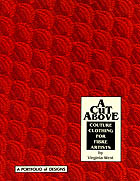
by Virginia West
8 1/2" x 11" Softcover (43 pages)
1992, Virginia West
$25.95 Canadian ($21.95 US)
In semantics "a cut above" implies something other than the run of the mill, usual way of looking at things. In this book, A Cut Above applies to clothing, distinctive and personal clothing that you hope to find in couturier collections, but never do, at least not at the price you can afford.
The author has put together a portfolio of 26 designs for tops, dresses, pants, skirts and other clothing. The collection includes: "Top of the Line", "Cropped Top", "Bias Mini or Tunic", "Bewitching Bias Blouse", "Pantaloons", "Harem Pants", "Square One Summer Tank Top", "Square Two Cowl Blouse & Skirt", "Square Two Dress", "Dynamic Diagonals Blouse", "Dynamic Diagonals Summer Shift", "Butterfly Blouse", "Spiral Shift", "Sharon's Shift", "Chemise Traveller", "Angel Wing Fringed Blouse", "Wondrous Winter Sweater", "Jane's Jacket", "Angel Wing Blouse III", "Dolman Delight", "Laced Panel Vest", "Josephine's Coat of Many Colours", "Scheherazade", "Salome", "Detachable Bias Cowl" and "Bias Turtleneck Collar".
Each design in this book includes a set of instructions on weaving the cloth and cutting and sewing the garment. A collection of finishing tips is also provided making this an excellent guide for any weaver interested in turning their woven fabric into clothing.
The author has also written Designer Diagonals: Portfolio of Patterns for Bias Clothing and Finishing Touches for the Handweaver.
|
How to Order: Orders may be placed using our secure Online Order Form (this form should open in another window). Click Here for more information on how to place an order as well as our terms and conditions. Payment/Currency: Payment can be made using VISA or Mastercard, Cheque or Money Order in US or Canadian funds. US credit card purchases are billed directly in US funds eliminating any foreign currency conversion charges by the credit card company. Product Directories If you are looking for other items on our website, try using our product directories to quickly find what you are looking for! Our products are grouped as follows: Weaving/Spinning Product Index Books, Magazines & Videos. |
Price/Shipping Quote? If you would like an exact quote for any items complete with shipping costs, please call or email us at nmanners@camillavalleyfarm.com with you location and we will provide this. Gift Certificate If you are looking for a gift for a Knitter or Weaver and can't figure out what they want, a Camilla Valley Farm Gift Certificate is an excellent way to ensure you get the perfect gift! We can also email gift certificates if you are running out of time! Latest News/Updates Keep up to date with what is new at Camilla Valley Farm by following us on Instagram! (Click on the logo below)  |